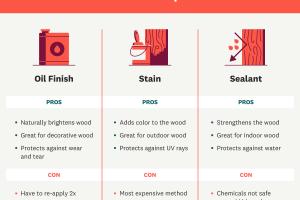3 Simple Techniques to Waterproof Wood for Long-lasting Durability

-
Quick Links:
- Introduction
- Why Waterproof Wood?
- Technique 1: Using Water Repellent Preservatives
- Technique 2: Applying Varnish or Polyurethane
- Technique 3: DIY Beeswax and Mineral Oil Mixture
- Case Studies
- Expert Insights
- Conclusion
- FAQs
Introduction
Waterproofing wood is essential for anyone looking to maintain the integrity and aesthetic appeal of their wooden structures or furniture. Whether you’re dealing with outdoor decks, garden furniture, or wooden floors, moisture can be your worst enemy. In this article, we will explore three easy, effective methods to waterproof wood, ensuring its longevity and durability.
Why Waterproof Wood?
Wood is a natural material that is susceptible to rot, mold, and decay when exposed to moisture. Waterproofing wood can prevent these issues and protect your investment. Here are a few reasons why waterproofing is critical:
- Increased Lifespan: Properly waterproofed wood can last for decades.
- Enhanced Aesthetics: Waterproofing helps maintain the natural beauty of wood.
- Cost-Effective: Prevention is always cheaper than repair.
- Health Benefits: Prevents mold growth that can affect indoor air quality.
Technique 1: Using Water Repellent Preservatives
Water repellent preservatives (WRPs) are designed specifically to repel water and prevent moisture from penetrating the wood. Here’s a step-by-step guide to applying WRPs:
- Choose the Right Product: Select a high-quality WRP suitable for your wood type.
- Prepare the Surface: Clean the wood surface using soap and water. Allow it to dry completely.
- Application: Use a brush or sprayer to apply the WRP evenly. Ensure you cover all surfaces.
- Drying Time: Allow the product to dry as per the manufacturer’s instructions.
- Reapplication: For maximum protection, reapply every 1-3 years, depending on the exposure to elements.
Technique 2: Applying Varnish or Polyurethane
Varnish and polyurethane create a hard shell over the wood, offering excellent protection against water. Here’s how to apply these finishes:
- Choose the Finish: Decide between oil-based and water-based varnish or polyurethane.
- Surface Preparation: Sand the wood to remove imperfections and ensure a smooth finish.
- Apply the Finish: Use a brush or roller to apply the varnish in thin, even coats.
- Drying and Sanding: Allow it to dry, then lightly sand between coats. Typically, 2-3 coats are recommended.
- Final Cure: Let the final coat cure for at least 24 hours before exposing it to moisture.
Technique 3: DIY Beeswax and Mineral Oil Mixture
This natural method is particularly popular for indoor wooden furniture. It’s easy to make and apply:
- Ingredients: Combine equal parts of beeswax and mineral oil in a double boiler until melted.
- Application: Allow the mixture to cool slightly, then use a cloth to apply it to the wood surface.
- Buffing: Once it’s absorbed, buff the surface with a clean cloth for a nice sheen.
- Reapply: This treatment can be reapplied every few months to maintain protection.
Case Studies
To illustrate the effectiveness of these waterproofing techniques, let’s look at a couple of case studies:
Case Study 1: Outdoor Decking
A homeowner applied a water repellent preservative on their wooden deck. After two years, the deck showed minimal signs of wear and was free from rot, demonstrating the efficacy of WRPs in outdoor applications.
Case Study 2: Indoor Furniture
Another homeowner used a DIY beeswax and mineral oil mixture on a dining table. After frequent use and exposure to spills, the table remained protected, showcasing the benefits of natural products in indoor settings.
Expert Insights
We consulted with woodworking experts to gather insights on waterproofing wood:
"Choosing the right waterproofing solution depends on the wood's location and usage. For outdoor applications, a water repellent preservative is key, while indoor pieces benefit from varnish or natural oils." - John Smith, Woodworking Specialist.
Conclusion
Waterproofing wood is a straightforward yet crucial process for anyone who values their wooden items. By utilizing water repellent preservatives, varnish, or even natural DIY solutions, you can protect your wood from moisture and extend its life significantly. Implement these techniques to ensure your wood remains beautiful and functional for years to come.
FAQs
1. How often should I waterproof my wood?
It depends on the product used and exposure to elements, but generally, every 1-3 years is advisable.
2. Can I waterproof wood myself?
Absolutely! Many waterproofing methods can be easily done as DIY projects with proper guidance.
3. Is waterproofing necessary for indoor wood?
While not as critical as outdoor wood, waterproofing indoor wood can prevent spills and moisture damage.
4. What is the best waterproofing method for outdoor furniture?
Water repellent preservatives are highly effective for outdoor furniture.
5. Can I use any paint to waterproof wood?
No, not all paints have waterproofing properties. Look for specific waterproofing paints or finishes.
6. Is beeswax suitable for all wood types?
Beeswax works well on most wood types, but check compatibility with your specific wood type.
7. Does waterproofing change the wood color?
Some treatments can darken the wood; always test on a small area first.
8. How long does waterproofing last?
It varies by method and exposure, but typically lasts 1-3 years before reapplication is needed.
9. Can I use a sealant over varnish?
It's generally not necessary, as varnish itself provides a seal. However, a clear topcoat can add extra protection.
10. Are there eco-friendly waterproofing options?
Yes, natural oils like linseed oil, and DIY beeswax mixtures are eco-friendly choices.
References
- Understanding Water Repellent Preservatives
- Tips for Choosing the Right Wood Finish
- Guide to Waterproofing Wood
Random Reads
- How to shorten google maps urls
- How to copy a table from a pdf to excel
- How to clean sandstone
- How to clean slate floors
- How to remove epoxy
- How to remove e6000 glue
- How to remove echo from audio
- How to calculate z scores
- How to calibrate compass google maps iphone ipad
- How to change your email password